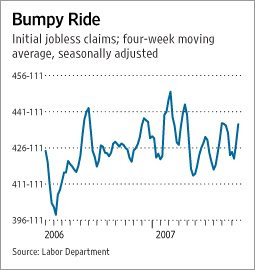
Economy's Weak Signals Persist
The Wall Street Journal (27 October 2007)
Housing, Jobs Data Raise Further Slowdown Worries; Some Bright Spots Emerge
The latest readings on the U.S. economy show continuing signs of weakness: Sales of newly built homes over the summer were weaker than previously estimated, September manufacturing was subdued, business inventories are mounting and the job market is displaying worrying signs of erosion.
The Wall Street Journal (27 October 2007)
Housing, Jobs Data Raise Further Slowdown Worries; Some Bright Spots Emerge
The latest readings on the U.S. economy show continuing signs of weakness: Sales of newly built homes over the summer were weaker than previously estimated, September manufacturing was subdued, business inventories are mounting and the job market is displaying worrying signs of erosion.
REAL TIME ECONOMICS
• Read the latest news and analysis on the economy at WSJ.com's Real Time Economics blog.
The data also offered some hopeful signs. New-home sales, albeit a volatile measure, logged a surprise 4.8% increase in September, and the inventory of unsold homes declined. Growth in business investment continues, though it has decelerated in recent months.
"We have all this weakness from housing but at the same point we have good business spending, good consumer spending, healthy exports. When you add it all up, you end up with an economy that's likely to grow, but grow at a smaller pace than in the past," said Drew Matus, an economist at Lehman Brothers.
The new information bolstered the view that the U.S. economy expanded at better than a 3% annual rate in the third quarter and largely upheld predictions that the fourth quarter will be weaker. "The data have been soft, but it's no softer than what's already in people's forecasts," said Haseeb Ahmed, an economist at J.P. Morgan Chase.
As concerns mount about the slowing pace of economic growth and the risks ahead -- from the nascent credit crunch to energy prices -- markets are increasingly anticipating that the Federal Reserve will cut short-term interest rates at its meeting next week.
The Commerce Department reported that new-home sales in June, July and August were revised down, offsetting the goods news about September. Still, the inventory of unsold homes shrank to 8.3 months' supply from nine months in August; the median sales price rose, but the average price slipped.
Skeptics aren't convinced that the bounce in new-home sales suggests the worst of the housing mess is over. "New-home sales numbers are notorious for being volatile and for being revised," said Patrick Newport, an economist at Global Insight, a research firm in Boston. As evidence of continued distress, economists pointed to the 10.2% decline in new-home construction last month, as well as the 8% drop in sales of existing homes, which account for more than 85% of all home sales, reported earlier this week.
And the new-home sales report doesn't reflect cancellations. If included, they would likely drag down the tally. D.R. Horton Inc., the largest U.S. home builder by sales, reported last week that almost half of its home orders were cancelled in July, August and September.
A separate Commerce Department report on manufacturing showed that business investment hasn't yet succumbed to weakness elsewhere in the economy. Orders for durable goods, which are intended to last three years or more, fell 1.7%, largely on a decline in defense-related orders. Excluding defense, orders rose 0.7%. Orders for nondefense capital goods excluding aircraft, an important gauge of capital spending, rose by 0.4%, and the previously reported August decline was revised to show a shallow 0.1% gain.
The Labor Department reported that claims for unemployment benefits fell by 8,000 to 331,000 last week; the four-week moving average rose to 324,750, the highest level since the beginning of September and a hint that the labor market is weakening.
Continued strength in the job market is essential to keeping consumer spending going. Earlier this week, women's clothing retailer Talbots Inc. cut its sales forecast for the fall season, saying the "continued uncertainty of the economic environment" was weighing on consumers. Luxury retailer Coach Inc. warned that holiday profit would miss targets because of weak traffic at its U.S. stores and Target Corp. lowered its October same-store sales forecast.
No comments:
Post a Comment